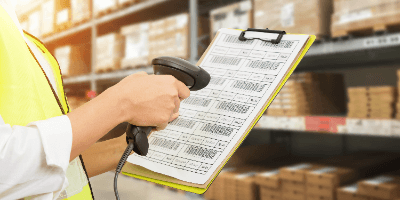What Is a Barcode Reader?
 A barcode reader is a device that optically reads the numbers and characters represented by a barcode and picks up the information contained in the barcode.
A barcode reader is a device that optically reads the numbers and characters represented by a barcode and picks up the information contained in the barcode.
Most barcode readers on the market today consist of a light source using an infrared laser, a part that receives the reflected light, and a part that sends the scanned data to a PC.
Uses of Barcode Readers
Barcode readers are used to read barcodes on products to manage the distribution of goods in the logistics industry. Barcode readers are also indispensable for other purposes, such as managing drugs in the medical field and cash registers in supermarkets and convenience stores, in order to improve convenience.
QR codes, which are familiar through smartphone applications, are also a type of 2D barcode, and there are barcode readers on the market as well as smartphones that can read these codes.
Principle of Barcode Readers
The principle of barcode readers is based on the physical phenomenon that laser beams emitted on the black areas of a monochrome line are absorbed and only laser beams emitted on the white quiet zone are reflected. When a laser beam is applied to a barcode and scanned, the light receiving element recognizes the presence or absence of reflected light and reads the line information of the barcode as an analog signal.
Next, the weak analog waveform acquired by the light receiving element is amplified and converted into a digital signal, with the values exceeding a certain threshold being set to 1 and other values to 0, and decoded.
At this time, care must be taken not to irradiate the laser at a right angle to the barcode. If the laser is irradiated at a right angle to the barcode, the barcode will receive strong direct reflected light, which will cause its output to be too large compared to the other diffuse reflected light, and a clean analog waveform will not be obtained. For this reason, many barcode readers must be set up so that the laser is obliquely incident on the barcode.
Types of Barcode Readers
There are several types of barcode readers in terms of the codes they read and the way they read them.
1. Read Code
- 1D Barcode Reader
There are two types of barcode readers: “laser engine type,” which reads barcodes by irradiating them with laser light, and “CCD engine type,” which reads barcodes by irradiating them with LED light. - 2D Barcode Reader
There are “long range type” that can read from close range to long range, “high performance CMOS type” that have high resolution and are resistant to blurring, and “low cost CMOS type” that are inexpensive but vulnerable to camera shake.
2. Reading Method
- Pen Scanner
Scanning is done by tracing with a pen. - Fixed Scanner
The reader is fixed in a specific position. - Card Reader
Reads barcodes on cards. - Hand-Held Scanner
Holds the reader in the hand and touches the reading area.
Other Information About Barcode Readers
1. Barcode Reader Reading Accuracy
The reading accuracy of a barcode reader is determined by the “read rate” and the “false read rate.” Read rate is defined as the number of successful reads relative to the number of barcode scans performed. For example, if the number of barcode scans is 1,000 and the number of successful reads is 995, the read rate is 99.5%. The false read rate is similarly defined by the number of false reads relative to the number of times read.
The read rate varies depending on the quality of the barcode label, the resolution of the barcode reader, the number of times it is read, and the decoding algorithm. Of these factors, the quality of the barcode label is the most significant.
If the barcode is free of dirt or scratches, the width of the code is within specifications, and the contrast is high, it can be read at a read rate close to 100%. However, the actual barcodes to be read are rarely clean, and manufacturers need to be able to read barcodes at a high read rate, even under adverse conditions.
2. Barcode Reader Interface
The communication interface used to read barcode reader data into a PC includes USB, RS232C, and PS/2 wired interfaces, as well as products with wireless connectivity, such as Bluetooth. Recently, the use of the USB type, instead of RS232C or PS/2, has been increasing along with the increased use of thin notebook PCs. Note that some USB type products are compatible with some PC operating systems, while others are not.
3. About Fixed Barcode Readers
Fixed barcode scanners are important devices in the manufacturing and logistics industries. Built into manufacturing equipment or installed in a fixed position, they use optical sensors or laser technology to read the barcodes of products or packages automatically as they flow down a conveyor. Depending on the reading distance and angle, short-range scanners and long-range scanners are available for efficient production control and tracking.